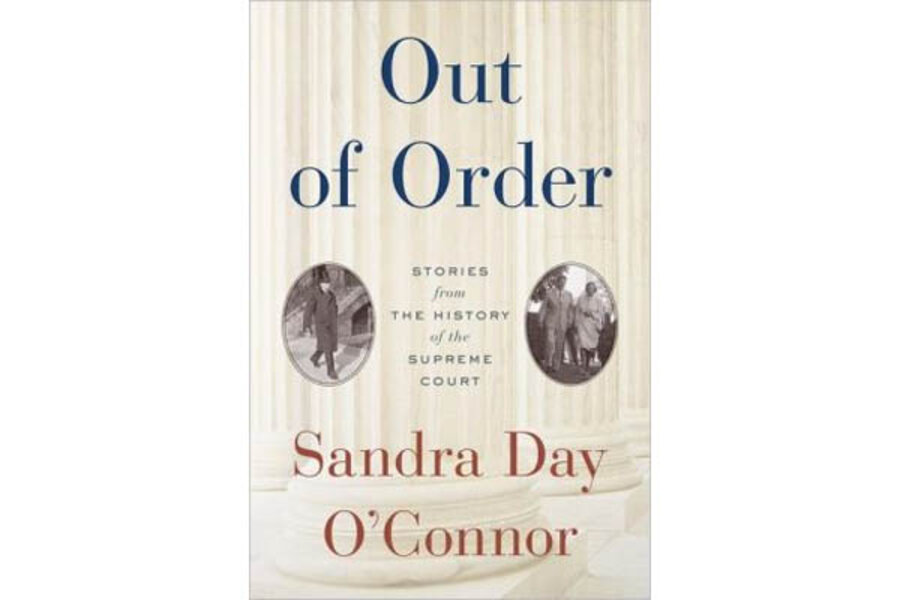Out of Order: Stories from the History of the Supreme Court
Loading...
In many respects, or at least in spots, Sandra Day O’Connor’s fifth book – her second dealing with the Supreme Court – is useful and engaging. The average reader will learn much from the former Supreme Court Justice who was the first woman to serve on the nation’s highest court.
On the other hand, Out of Order: Stories from the History of the Supreme Court is disappointing in that it breaks no new scholarly ground and studiously avoids wading into current or even historical controversies, such as the widely held belief that the court has become increasingly politicized in recent decades. The fact that 75 percent of Americans believe the justices make decisions based on their personal and political views, rather than objective legal analysis, is among the substantive issues not mentioned.
This book is all about the facts, just the facts. In the beginning, in 1789, the Supreme Court was smaller (six members), had no neoclassical building to call home, and, frankly, didn’t have a whole lot to do. It heard no cases in its first four terms. Justices were appointed and often bolted as soon as something better came along. John Rutledge left to head the South Carolina Court of Common Pleas. Had justices not been required to “ride the circuit” of federal district courts – literally, on horses – our highest court might have dissolved from acute boredom and irrelevance.
The reason for this slow start may be that the original intent of the drafters of the Constitution of the United States is decidedly vague. That august document addresses at length the powers of the Executive and Legislative branches in Articles I and II, but mentions the “supreme Court” in only a few rather unspecific sentences within a relatively brief Article III, which expounds on the Judiciary. Our highest court was clearly the tail of the federal dog.
Having a Supreme Court seemed like a good idea, but no one knew what to make of it once they had it. It was left to Chief Justice John Marshall, who stayed on the case for 34 years, to elbow the court’s way into being a player with the other two branches of the federal government.
As O’Connor points out repeatedly, the court has evolved. Oral arguments, for example, which once might ramble on for days – and remarkably, uninterrupted by the justices – are limited now to 30 minutes. Today the nine justices do not hear every case that wends its way through the system, but select some 90 a year – or roughly one percent of the 8,000 petitions they receive.
Such details are all well and good. They are fodder for a middling, middle school civics textbook. Indeed, the author’s prose often seems aimed at that audience: “Underneath their robes, so to speak, the Justices of the Supreme Court are real, often quite unique, people.” We learn how these real people have a collegial tradition of shaking hands before taking the bench, but not how they interact and come to a decision afterwards – for example in Bush v. Gore, in which O’Connor is widely viewed as having cast the deciding, or “swing” vote for the ideologically split court.
It is not simply that the author has decided not to “tell all,” as she refers derisively to examining insider aspects of her nearly 25-year tenure. In her haste to get on to the next judicial factoid, she fails to flesh out what ripping good stories she does include.
For example, the 1954 landmark case Brown v. Board of Education that outlawed segregated schools pitted future Supreme Court Justice Thurgood Marshall against John W. Davis, a legendary oral advocate who argued for “separate but equal.” Marshal, who in 1967 would be the first African-American to sit on the high court, idolized Davis and had watched him argue other cases before the Supreme Court. Davis, according to Marshall, was in tears after making his emotional case for segregation. The author abruptly ends the story there, leaving the reader malnourished: Why was Davis crying? What was Marshall thinking about facing his idol in such a highly charged and personal case? Did they speak before or after the verdict?
Further along O’Connor has another opportunity not simply to report on how the court has evolved, but to ruminate on where it is evolving to and how it might get there. A woman was selected by a Supreme Court justice to be a law clerk for the first time in 1944. The second would not be chosen until 1972, and female clerks are decidedly in the minority still. In 2011, O’Connor writes, there were 39 law clerks, only 13 of whom were women. She points out that women make up more than half of law school graduates today – then, characteristically, she moves on without further ado.
Again, the famished reader would like to know, at minimum: how many of the author’s law clerks were women, why does she feel the imbalance exists, and what might be done to make the justices less biased – at least in this one area.
Unfortunately, in opting not to tell all, the author has told us very little.
David Holahan is a contributor to The Christian Science Monitor








